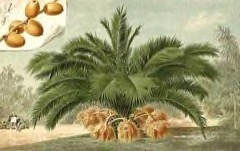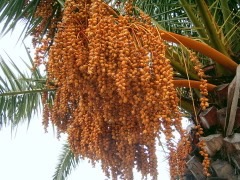 |
|
edibleplants.org |
 |
| Frank Vincentz wikimedia.org |
Translate this page:
Summary
Physical Characteristics

 Phoenix is an evergreen Tree growing to 12 m (39ft) by 8 m (26ft) at a slow rate.
Phoenix is an evergreen Tree growing to 12 m (39ft) by 8 m (26ft) at a slow rate.
See above for USDA hardiness. It is hardy to UK zone 9.
It is noted for attracting wildlife.
Suitable for: light (sandy), medium (loamy) and heavy (clay) soils, prefers well-drained soil and can grow in heavy clay soil. Suitable pH: mildly acid, neutral and basic (mildly alkaline) soils and can grow in saline soils.
It cannot grow in the shade. It prefers dry or moist soil and can tolerate drought. The plant can tolerate maritime exposure.
UK Hardiness Map
US Hardiness Map
Synonyms
Phoenix canariensis var. porphyrococca Vasc. & Franco. Phoenix cycadifolia Regel. Phoenix dactylifera var. jubae Webb & Berthel. Phoenix erecta Sauv. [Invalid]. Phoenix jubae (Webb & Berthel.) Webb ex Christ. Phoenix macrocarpa Sauv. [Invalid]. Phoenix tenuis Verschaff. [Invalid]. Phoenix vigieri Naudin.
Plant Habitats
Edible Uses
Edible Portion: Fruit, Sap. Fruit weigh 1.7 g. The fruit are reported to have an edible outer pericarp. The fruit are orange, 2 cm long and 1 cm diameter, with a large seed; the fruit pulp when ripe (solid black) is edible, but usually too thin to be worth eating. They are a famine food. Inflorescence buds are tapped for the sweet sap which is eaten as syrup or palm honey. Carbon Farming Solutions - Staple Crop: sugar (The term staple crop typically refers to a food that is eaten routinely and accounts for a dominant part of people's diets in a particular region of the world) [1-1].
References More on Edible Uses
Medicinal Uses
Plants For A Future can not take any responsibility for any adverse effects from the use of plants. Always seek advice from a professional before using a plant medicinally.
None Known
References More on Medicinal Uses
The Bookshop: Edible Plant Books
Our Latest books on Perennial Plants For Food Forests and Permaculture Gardens in paperback or digital formats.

Edible Tropical Plants
Food Forest Plants for Hotter Conditions: 250+ Plants For Tropical Food Forests & Permaculture Gardens.
More

Edible Temperate Plants
Plants for Your Food Forest: 500 Plants for Temperate Food Forests & Permaculture Gardens.
More

More Books
PFAF have eight books available in paperback and digital formats. Browse the shop for more information.
Shop Now
Other Uses
A very ornamental tree - it has gained the Royal Horticultural Society's Award of Garden Merit. The leaflets are used in much the same way as those of P. dactylifera for a range of woven products including crosses for Palm Sunday celebrations.
Special Uses
References More on Other Uses
Cultivation details
Climate: Mediterranean. Humidity: semi-arid. Found at elevations from sea level to 1,200m in a range of habitats, from humid areas just below cloud forest to semi-arid areas where its presence usually indicates groundwater. Cultivated in wet-winter or Mediterranean climates, but also in wet-summer or humid subtropical climates like eastern Australia and the southeastern United States. Examples in high-latitude oceanic climates, such as Ireland, the UK, and the Channel Islands. It can be cultivated where temperatures rarely fall below -10°C (14 or 10 °F). Light: Full Sun. USDA Hardiness Zone 8a: to -12.2°C (10 °F) to 11: above 4.5 °C (40 °F). Drought-tolerant; suitable for xeriscaping. It is very frost hardy and thrives on poor soils. It needs good drainage. Soil pH requirements: 6.1 (mildly acidic) to 7.8 (mildly alkaline). Carbon Farming Solutions - Cultivation: regional crop. Management: standard (Describes the non-destructive management systems that are used in cultivation) [1-1]. Normal height range 10–20m (33–66 ft) tall; some specimens have reached 40m (130 ft).
References Carbon Farming Information and Carbon Sequestration Information
Temperature Converter
Type a value in the Celsius field to convert the value to Fahrenheit:
Fahrenheit:
The PFAF Bookshop
Plants For A Future have a number of books available in paperback and digital form. Book titles include Edible Plants, Edible Perennials, Edible Trees,Edible Shrubs, Woodland Gardening, and Temperate Food Forest Plants. Our new book is Food Forest Plants For Hotter Conditions (Tropical and Sub-Tropical).
Shop Now
Plant Propagation
Plants are grown from seed. Seed germinates readily. It takes 1-2 months to germinate. In tropical locations suckers can be used.
Other Names
If available other names are mentioned here
Canary Island palm, Canary Island date palm, date palm, phoenix palm, Pineapple Palm, Canary Date Palm, Slender Date Palm, Palem korma kannari
Native Range
AFRICA: Spain (Canarias)
Weed Potential
Right plant wrong place. We are currently updating this section.
Please note that a plant may be invasive in one area but may not in your area so it's worth checking.
Phoenix canariensis is an invasive plant. It is listed as invasive in California. In Auckland, New Zealand, the palm has itself become a host for the naturalised Australian strangler fig, Ficus macrophylla.
Conservation Status
IUCN Red List of Threatened Plants Status : Status: Least Concern

Growth: S = slow M = medium F = fast. Soil: L = light (sandy) M = medium H = heavy (clay). pH: A = acid N = neutral B = basic (alkaline). Shade: F = full shade S = semi-shade N = no shade. Moisture: D = dry M = Moist We = wet Wa = water.
Now available:
Food Forest Plants for Mediterranean Conditions
350+ Perennial Plants For Mediterranean and Drier Food Forests and Permaculture Gardens.
[Paperback and eBook]
This is the third in Plants For A Future's series of plant guides for food forests tailored to
specific climate zones. Following volumes on temperate and tropical ecosystems, this book focuses
on species suited to Mediterranean conditions—regions with hot, dry summers and cool, wet winters,
often facing the added challenge of climate change.
Read More
Expert comment
Author
Chabaud
Botanical References
Links / References
For a list of references used on this page please go here
Readers comment
| Add a comment |
|
If you have important information about this plant that may help other users please add a comment or link below. Only comments or links that are felt to be directly relevant to a plant will be included. If you think a comment/link or information contained on this page is inaccurate or misleading we would welcome your feedback at [email protected]. If you have questions about a plant please use the Forum on this website as we do not have the resources to answer questions ourselves.
* Please note: the comments by website users are not necessarily those held by PFAF and may give misleading or inaccurate information.
To leave a comment please Register or login here All comments need to be approved so will not appear immediately.
|
|